Update:
Not long after I posted this article, which details my process of creating a full animated sequence in Mario Paint a year and a half ago, my animation was taken down from YouTube due to a copyright complaint.
From the very beginning, I was aware that my video could be taken down, so I purposely designed the video to be as transformative under Fair Use as I possibly could. Everything was manually drawn by hand using a reference offscreen. There’s no way to download images into Mario Paint, nor is there any way to trace anything, and the limitations of Mario Paint actually make it impossible to perfectly recreate the original (the article that follows will explain why in detail). And, a new cover version of the song was recorded specifically for this video. I was under the impression that I was so far ahead of what was required that I would be completely in the clear, and then some.
If the animation I made in Mario Paint doesn’t count as transformative, then I’m not sure what even does. What if I had recreated the intro using claymation? What if I had used actors in costumes? What if I just used a recording of me singing the theme song in the shower? Where is the actual line that got crossed?
I want to know what aspects of my video supposedly don’t qualify as Fair Use. Hopefully I can manage to get that question answered at least. I’m sure other creators could find the information useful as well.
Anyways, the video got reposted by someone already if you didn’t get a chance to watch it. It very well may get deleted again, so save it and if you want and share it on other video players and blogs so half a year of work isn’t tossed out a window forever..
See the video here:
https://www.vidlii.com/watch?v=PlV2cAO9kf1
https://www.bitchute.com/video/bfyvFFHA4Aw5/
Of all the art forms, animation seems to be the one affected by economics the most. Film is another big one for sure, but animation is such an incredibly manual, labor-intensive process that there’s a giant disconnect between creative vision and what can actually be reasonably produced, and what can reasonably make money. Since animators are painstakingly creating moving pictures frame by frame, simple creative decisions can multiply into hours, months or even years of extra work. Concessions always have to be made, and the work doesn’t always pay off.
In 2016, I used the Super Nintendo game Mario Paint to recreate the intro to the 80s Teenage Mutant Ninja Turtles cartoon opening. Here is the original video that was taken down. Use the links above to see the animation.
There were a lot of candidates to choose from (Thundercats, X-Men, Ducktales were also high on my list), but I chose TMNT because it seemed to be the most likely to reach a wide audience. I knew from the outset that this was going to be a big undertaking, and it took me roughly 6 months to complete.
The reasons to animate using Mario Paint are probably what you’d figure. Since I’m known as a commentator on retro video games, it was appropriate to use an art tool from a retro games console. There aren’t really many other choices that fit the bill, and there’s no way I could have used the LJN Video Art console to do it, being the completely useless art tool that it is that’s not even suitable for use by children. Also, there’s the element of the masochistic spectacle of one man going through the grueling process animating a full sequence working within such strange limitations. I thought people would be into it, and thankfully a good amount of people were.
Mario Paint was a wonderful toy for its time, and Nintendo was smart enough to add game elements, humor, and quirky flair to the experience instead of just making it a basic electronic art program. But as an art tool, the limitations are numerous. It’s very strange in that it’s essentially a tool to create pixel art, but offers extremely limited pixel precision (save for the pixel art stamps you can define, which weren’t suitable for my project).
The game came bundled with a mouse, but laser mouse technology didn’t exist in 1992. The Super Nintendo mouse used a rubber ball that rolled along the mousepad to manipulate rollers inside the unit to move the cursor onscreen. Everything grinds to a halt with this mouse if anything gets dirty, and the mouse is in a constant hurry to get as dirty as it possibly can. People reading this who grew up with Mario Paint will remember the cursor snagging over and over and the constant struggle to keep it clean. This was my life for 6 months.
As for other limitations, lines need to be drawn extremely slowly in Mario Paint, because moving the cursor too fast will result in dotted lines streaking across the screen. Not to mention every pen stroke overwrites the color underneath, as there is no layering functionality, so trying to build colored shapes with an outline requires a bit of planning in advance. In Mario Paint, I typically lay down color blobs and then add black outlines around them as the very last step, which is backwards from the way most people draw.
This is three lines drawn in Mario Paint at different speeds of strokes with the mouse.
The limitation of Mario Paint that’s probably the most regrettable is the dismal color selection. There are only 15 solid colors, and 15 extra colors which are the basic colors combined in various ways in a pixel checkerboard pattern.
There’s a reason why you don’t see actual pixel artists use patterns like this for coloring, because the results are usually hideous.
Unfortunately, an artist working within the restrictions of Mario Paint will have to use these extra colors sometimes, for better or worse. Outside of these 30, there’s also several pages of stuff that I rarely find a use for at all.
There’s no shortage of eye-melting color patterns to choose from, although these look better using the Spray tool.
This is due to the limitations of the hardware of the SNES. I’m not a programmer and I wasn’t able to find any detailed information on how Mario Paint’s code works, but here’s my best guess of what’s going on: The canvas area of Mario Paint is 248×168 pixels, which means it’s made up of 8×8 tiles, 31 horizontal and 21 vertical. The SNES has 16 colors to work with in each 8×8 tile, which means Mario Paint is using the maximum amount of colors the console can support (I’m guessing that one color has to be left unused for transparency, possibly to allow the cursor to hover over the drawing area). Also, the SNES can only display 34 of these tiles per horizontal row, so there’s 31 tiles for the canvas, 2 tiles for the border around the screen, and 1 left over that allows for the cursor.
Which means, as much as I lament the poor color choices, I can’t blame the creators of Mario Paint. They squeezed as much functionality out of Mario Paint as the hardware allowed. The checkerboard colors and blob patterns was the only way to extend the colors available. (By the way, if you’re knowledgeable about how Mario Paint or the SNES hardware works and anything I said is incorrect, let me know and I’ll edit this article with the correct information and give you credit).
The color limitations also played a big part in why I chose the TMNT opening. Mario Paint offers two solid shades of green, which would allow me to add shadows to the Turtles’ skin.
The character design of the Turtles just happened to work really well with Mario Paint’s colors, and I could get a bit more mileage out of light and shadow.
There’s also an undo history of exactly one action, which is offered to you by the dog icon. Saving and loading is limited and slow, the flood fill tool is slow (although it can be cancelled in the middle to partially fill things), the animation function is limited to 4 drawable frames… I could go on and on about the limitations of Mario Paint, but I think you get the point.
So, as I just mentioned, Mario Paint has a pretty limited animation suite, so I used modern capture technology to simply capture frames when I completed them, and then edit them together later in video editing software. This could have been done in 1992 as well. I have friends who would use their VCR to record Mario Paint onto VHS and string them together to make elaborate animation projects, as well as other Nintendo art tools such as the GameBoy Camera placed into a Super Game Boy. VCRs connected to a camcorder could also be used to do stop motion animation with clay or toys, and even film individual frames of drawings to make animations.
This process was super nerve wracking, because each completed frame had to be discarded from existence entirely once I was done grabbing them. At least data storage is easy nowadays and I didn’t have to worry about someone in the house overwriting my animation in order to record an episode of Roseanne from the TV.
So, we come back to the concessions I talked about at the beginning. The original animated sequence for the TMNT show totals up to about 1200 individual frames of animation. So if I averaged about an hour per frame drawing in Mario Paint, and I worked 8 hours a day, that would mean I would reasonably get 8 frames done per day. Which means it would take 150 days of nonstop work to get the animation done, which would be okay if I didn’t also have a full time job and a social life that needs to be taken care of as well.
My animation ended up with about 420 frames total, and took me 6 months. So doing 1200 frames would have taken a year and a half, and who knows how much I would slow down from fatigue after a project that long. There were a couple times I could get a break, such as some frames just being a single solid color (such as lightning flashes), and I reused the swirling TMNT logo from the beginning for the end.
Hey, the original cartoon reused this animation, why can’t I?
I mentioned earlier that Mario Paint doesn’t offer any layer functionality, so this is a huge problem when animating moving characters over a background. As you can see in the above example, the background is constantly being destroyed by the turtles moving across the screen, and that destroyed information has to be rebulit when the portion of the background comes back into view.
Eagle-eyed readers will probably notice that this scene had to be animated out of sequence and then reassembled, which accounts for the way the background constantly changes shape.
Surprisingly, the shots you would think would be more difficult to do, such as Donatello flying around the city and the background moving around really fast, are about the same difficulty as the shot you see above, because of the lack of background layers. When the background is moving so quickly, redrawing the entire frame isn’t that much worse.
Oh who am I kidding, this was still painful.
Another issue came from the fact that I wasn’t going to use all 1200 frames from the original animation, so I had to pick and choose which frames to use. I was referring to a television off to the side drawing these individual frames, and I tried to pick out individual frames that would convey the most movement. This resulted in a bit of a discontinuity in the framerate, which had to be corrected manually when it came time to edit. This is why you see the framerate fluctuate often during the entire sequence. This is regrettable but… I dunno. Nobody has really complained about it, and if they did I’d just shrug and say Mario Paint isn’t the optimal tool to create animation. I did the best I could, you know?
Recreating an animation sequence in Mario Paint is so ridiculously transformative that it easily meets the requirements for Fair Use, so in order to keep my video from getting taken down, I was going to need a cover version of the music instead of using the original audio. Luckily I was able to get a great one by Epic Game Music, that was tailored to match the timing of the video I animated. After that was done, it just needed some editing and it was completed.
So there you have it. How do I feel about this animation more than a year later? I’m glad I did it because it’s something nobody had ever done before. Doing something this elaborate with the drawing section of the game. Sure a lot of people have done a lot with the music portion, and there is a very small limit to what you can do with the in-game animation tool. But to animate something like this with the basic drawing tool, I’d say I did the most elaborate thing anyone ever attempted. If there’s anything else out there even close to as time consuming, I’d love to see it.
I think it was a really good personal exercise for me in diligence and determination. I’m glad that I managed to finish it. Starting a project like this and then abandoning it halfway would have been a gnawing regret I would have had to carry for the rest of my life. The end result wasn’t perfect, but it’s more important to me that I finished it.
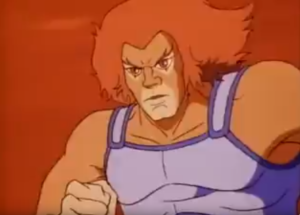 “I may lose, but it won’t be because I gave up!”
“I may lose, but it won’t be because I gave up!”
As for economics… all told, I only made a couple hundred dollars off the video. I’d do the Pat-Math on how much my hourly wage was, but you can guess it’s low enough to be just about nothing. But hey, that’s the game we play being creatives. You never know what’s going to hit or miss, and you just have to keep consistently applying yourself until something hits. Whenever I get negative feelings about this animation, I have to remind myself that it was more than made up for with a lot of other successes that required far less effort. Not to mention I’m a Let’s Player and a streamer where I record myself playing art that other people made, and standing on the shoulders of giants to do so. I’m grateful for the wonderful life I have, and I hope you guys don’t get the impression that I made this post just to whinge about making cartoons in Mario Paint.
Animation is extraordinarily difficult, but we’re in a strange time where animation is easier to make than ever before, yet independent animators aren’t making the money they probably should. And yet… so many people still animate. There’s so much incredibly good animation being made by individuals on YouTube and all over the internet. Against overwhelming odds and minimal rewards, they still painstakingly download their imaginations into individual frames, one by one. I believe strongly that things will get better for animators in the future.
Just like Lion-o up there, they just need to keep running. Eventually something good will happen.

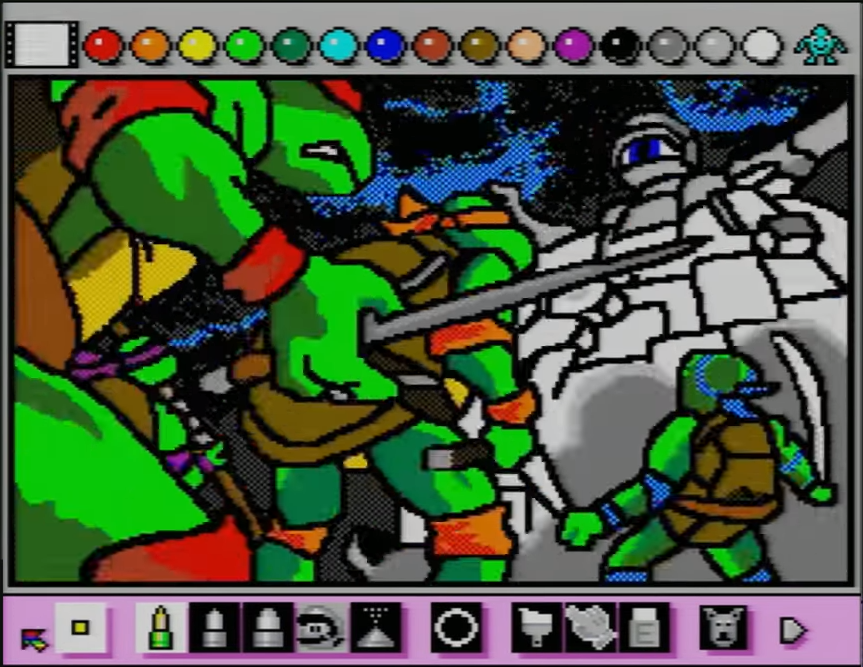

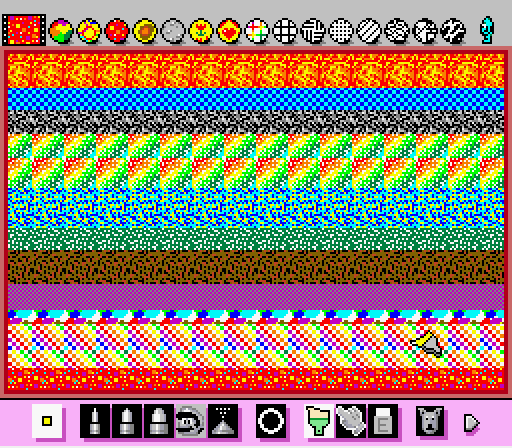

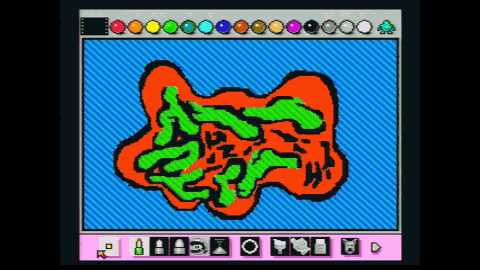

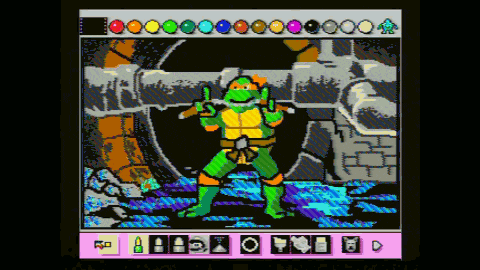
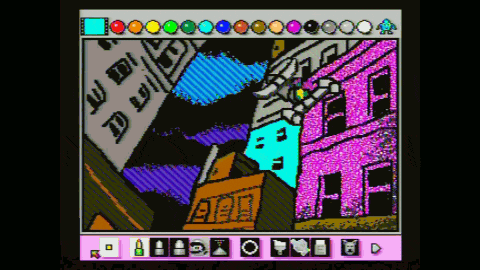
Awesome post Mike. I remember watching this when you first released it and I was blown away. It’s super interesting to hear you go into detail about the process of making such a painstaking piece of art.
Great job Mike, it’s a bit weird the video says “Not available in your country”….yet, I’m in New York. Other videos on Cinnemassacre work fine. Otherwise, amazing dedication, brilliant work.
I saw this video originally but had no idea it was so complicated to do. You are a Mario paint master. Plus since I am a TMNT fan from that era it was even cooler
It says I can’t watch the video in my country (USA)? lol
U got fucked Mike but ur animation was awesome
Mike the maestro does it again.
It’s dissapointing that your video got removed, but one thing to remeber is that fair use is a defense useable in court, not an inherited right.
First video says not available in my country and I’m in the USA
Mike, you’re the Mario Paint master as far as I’m concerned! Animating is frickin’ hard and time-consuming, I used to draw with a mouse when I was a kid, I’m used to drawing with a stylus and tablet and I can’t imagine going back to mouse-drawing, let alone using the shitty SNES Mouse. I had Mario Paint, I remember how terrible that mouse was, it was always sticking and you’d have to fight it constantly. I’m bummed your video got taken down from Youtube, it’s totally in fair use! I’m glad it’s posted elsewhere for people to see, at least. And yeah, I do hope you’re right that things will get better for indie animators.
About the fair use thing, I think that video might not be really transformative. Both videos (your intro, and the original intro) have the same goals: to entertain, and to make money, both using the same intellectual property. Now, if you made a documentary about how you made the intro, that might actually be truly transformative, because now you would be educating people (on how to do a Mario Paint Animation with the TMNT). I think their logic is “Oh, if they see his video, they wont watch our video, so we are loosing money”. I know it sound ridiculous, but that’s how corporations do things around here.
I’m on your side, Mike. This video is awesome, and you should be rewarded for all that hard work!
This reminds me of forgotten memories. As a kid i used, Was it called walt disney animator on amiga i believe. Good times 🙂
“Pat-math”
Hilarious, Mike!
Wishing you the best
Only thing I can think of is the use of the song and the connection to the Cinemassacre brand?
I hope you can get it back up one day because you did a great job with it and I know it must have taken a long time and a lot of effort.
Kudos
It’s really a shame they made you pull this down. I was impressed when you first uploaded the video. But I never used Mario Paint, so I’m even more impressed after reading just how difficult it was. Haven’t seen a Mario Paint stream in a while, by the way. Those are always fun and seem to get good audience interaction.